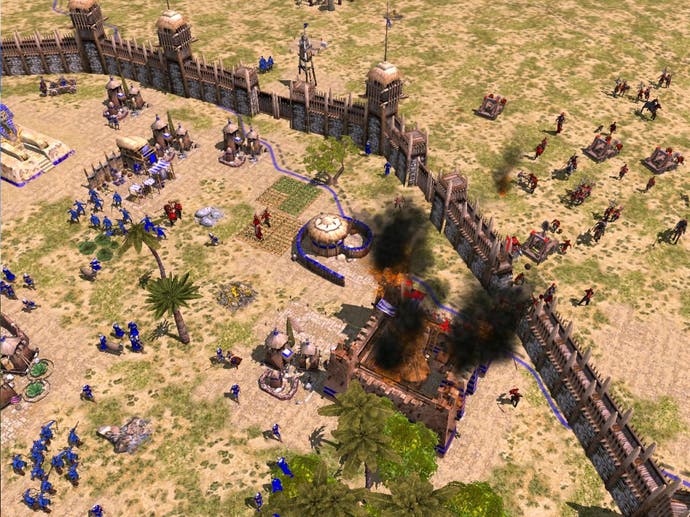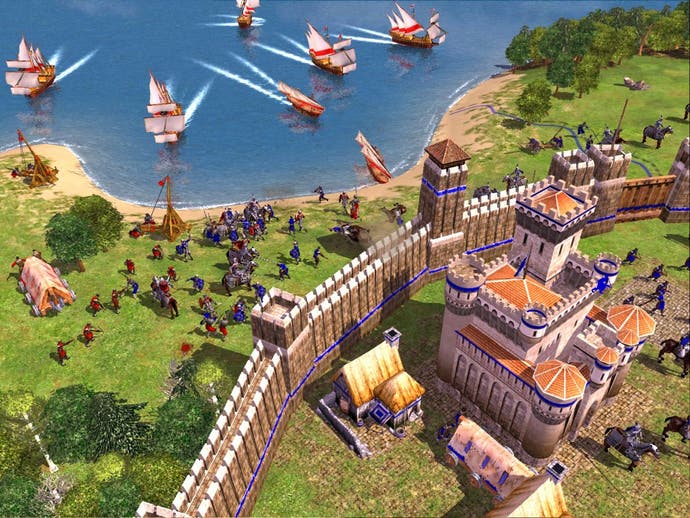Empire Earth II Review
The Empire Earth strikes back.
It's always been a good title for a videogame. Where most real-time strategy games seem to fall into the X of Y nomenclature, Empire Earth had a certain militaristic grandeur to it. It captures the game's themes better than competing titles like Age of Empires or Rise of Nations. That is, that the entire history of humanity has been the tale of two groups of cavemen hitting each other with increasingly large rocks. No matter who's the victor, the Empire remains.
It's a good name. It's a good game. But that's all.
Empire Earth II is a historical real-time strategy game, which attempts to cram in several thousand years of scientific development into a few hours. This follows on from the original, in that while there are epochs ranging from the pre-history of the Stone Age to the speculative history of the Synthetic Age (starts 2130, sci-fi fans), it's extremely unlikely that in a single skirmish game you'll go from one end to the other. Essentially, this means that the game features an excitingly long technological tree where games are started at a pre-chosen point. Other than that, the basic mechanics are familiar, based around a mixture of gathering resources, constructing settlements, producing armies and researching the aforementioned bigger rocks.
Structurally, much is familiar too. Four and a half narrative campaigns are included, one being a training-style affair dealing with an alternate history of the Aztecs (disappointingly low on human sacrifice, alas), and the other three being Koreans, Germans and Americans. The extra half comprises some missions involving turning points in history, such as the D-Day landings. A mission editor is included, guaranteeing there will be future fan-constructed experiences in addition to what comes with the game. Best of all, there's a particularly powerful skirmish mission generator including multiple game types.

While, yes, this is familiar, it's worth stressing at this point that it's all well designed. The campaign missions are some of the better examples of the type I've recently played, mixing up the challenges delightfully. However, since this is mostly rote, instead we're going to have a look at what actually distinguishes Empire Earth II from its peers. We'll start in the next paragraph.
Not this one. This one's a grammatical joke paragraph, for added self-indulgence points.
Its most interesting aspects involve expanding the toolset of the humble RTS. The best of Empire Earth's innovations are relatively simple ideas which I'm sure we'll see plundered two years down the road when everyone else has had a chance to add them to their design docs.
Firstly, it features extensive use of window-within-window technology. The bottom right of the screen is devoted to a second screen, which you can use to look at any part of the revealed battlefield. So, you can - for example - place it over your base to keep an eye on anything that's happening there while you run off and control the battle on the main screen.
Not only this, but you're able bookmark six different positions on the battlefield, which you can then switch between with F1-F6. So rather than just looking at one in the mini-window, you're able to look after all six. And this is actually turned from mere observing into actual utility, as you're able to actually give orders and select items inside the area by just clicking as you would anywhere else. It's not just a view-port: it's actually a second game window.
This is incredibly handy in situations where you want to change what your production queues are back in base. Instead of getting there manually, you can click the building in question in the mini-window and change things on the fly. It's also especially useful when you want to move the production destination waypoint to somewhere far away, such as the battle frontlines. Select the base in the window, then right click in the main one to make your troops march off to wherever you want. It's like being handy, but handier.

It's splendid technology and I'd have slaughtered a few French noblemen to have something similar in the recent Cossacks 2. The only problem is that despite the relatively low graphical fidelity of Empire Earth II, it can still cause a considerable hit on performance. In terms of multiplayer games, you can see people with lower powered machines suffering a considerable handicap, in the same way as Quake 3 players with weak machines back in the day.
Secondly, diplomacy. While treaties and tributes are commonplace in the genre, there's the ability to construct a simple war plan, marking areas of advance on a map and then sending it to your allies. While it's of obvious use for co-ordinating attacks in multiplayer, that you can also influence your computer allies to act in a way you'd actually want is most welcome. Obviously they can reject the war plan, but it does create a sense that you're playing with something more like a human player.
Thirdly, and perhaps best, the management of your citizens. Generally, Empire Earth II follows the standard RTS template by relying on the plucky proletariat to chop wood, hunt food and (eventually) mine uranium. However, it has some neat ideas to make looking after them a little more fluid. While standard micro-management is included, you can also give more generalised orders to units on the economic map screen. This displays the locations of discovered resources and how many people are working on each. By right-clicking to remove a citizen and left-clicking to reposition them, you can set them to task appropriately across the world in a far more efficient way than most you'll find in most RTS games.
It's also possible to do it in a more generalised fashion on the main screen by performing the same left-click/right-click repositioning-of-citizens-thing on the resources bar. While it leaves the actual positioning of the workers to the computer, it's a huge boon that you're able to reassign fluidly your workforce without painstakingly searching for them.

The implementation is "good" bordering on "as good as you could reasonably hope for". If you're forced to critique it, you're lead to doing despicable things like noting that you wish it did more. As well as re-arranging citizens in that manner, couldn't you centralise production of troops? So that rather than having to locate your barracks every time you wanted more soldiers and then wandering over to your stables to get more cavalry, you could alter the build queues in a central menu. Well, yes, it would be nice - but when no one else is doing it, it's unfair to complain that Empire Earth isn't doing it either.
Its main problems are that, essentially, it's very much the traditional RTS and will be immediately familiar to anyone who's played a game in the mainstream of the genre since Age of Empires. While there are combat formations and similar, they clearly devolve within seconds of contact in favour of the usual massed brawl of heaving pixels. While there's a paper-stone-scissors system in place between the six groups of military sorts, the problem is - well - there's six sorts, each of whom is especially good against one sort and gets a bonus against a secondary sort. For a game which really does seem to be pushing the accessibility card as hard as it can, using this fairly bewildering matrix of concepts as a core game mechanic seems over-obtuse. In practice, most players will attempt to make a relatively balanced force and be damned with it. While it does leave lots of room for higher-level play in the online environment or higher solo difficulty levels, relegating it there seems a shame.
What still keeps Empire Earth II above the standard crowd is how its innovations impact the game proper. While it's very much about economic victory, with actual battlefield tactics (as opposed to prior-to-conflict choices in upgrading and production) very much secondary in terms of securing victory, that it manages to make this production side so slick and painless means that it rarely fails to be genuinely enjoyable.
As well as the primary novel thrusts, there's a selection of other elements to enliven things, such as a crowns system where the person best performing in one of three areas (military, economic and imperial) gets a limited-time power worth further bonuses. Also, rather than a blank battlefield the world is divided into regions, which can be controlled and cause disadvantages when someone else tries to construct on one. This funnels the conflicts into wrestling over areas rather than devolving into a more abstract free for all.
Ultimately, Empire Earth is a fun, solid RTS. But that's all. It fatally lacks a sense of creative vision other than just being a bit better than Rise of Nations, with its step-forwards more half-steps. In terms of a buying recommendation, if you're a genre-fan looking for the same old thing, but slightly better, then you'll be satisfied. But if you're looking for a new game when you go shopping for a new game, then this latest advance along the RTS tech tree has much to appreciate but not enough to demand the use of your precious resources.

